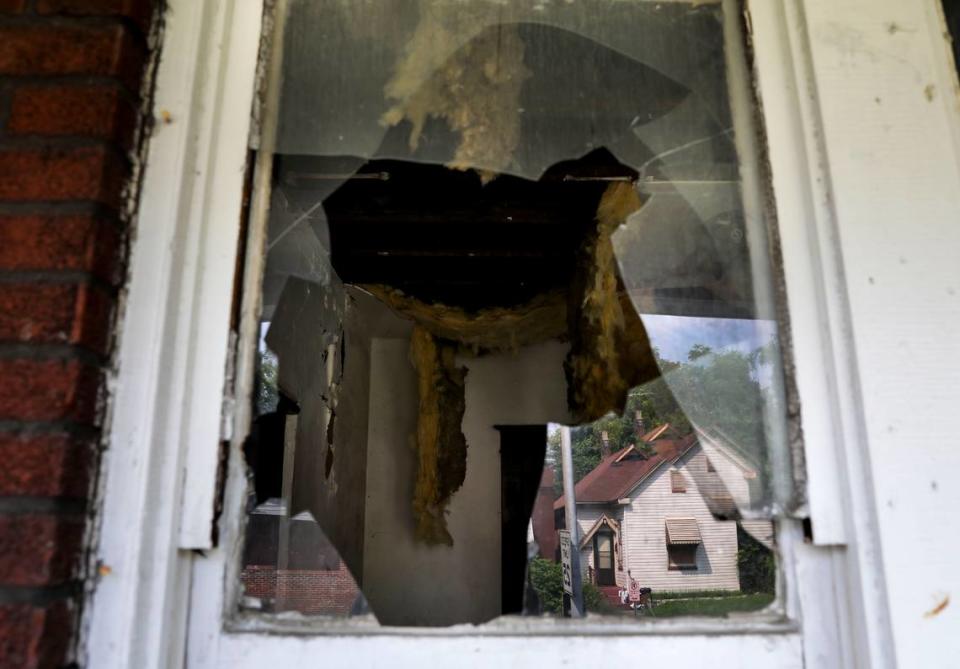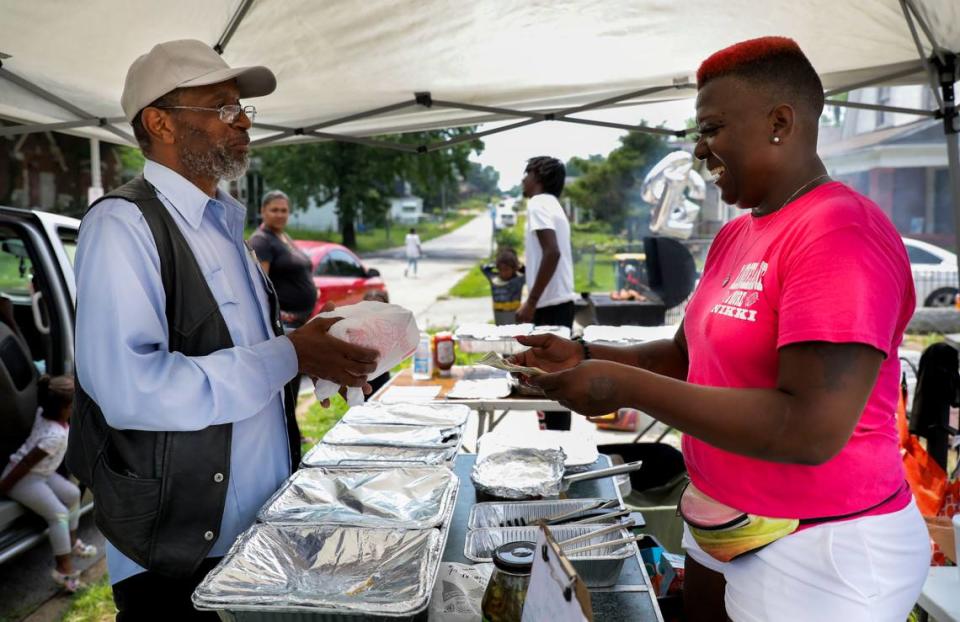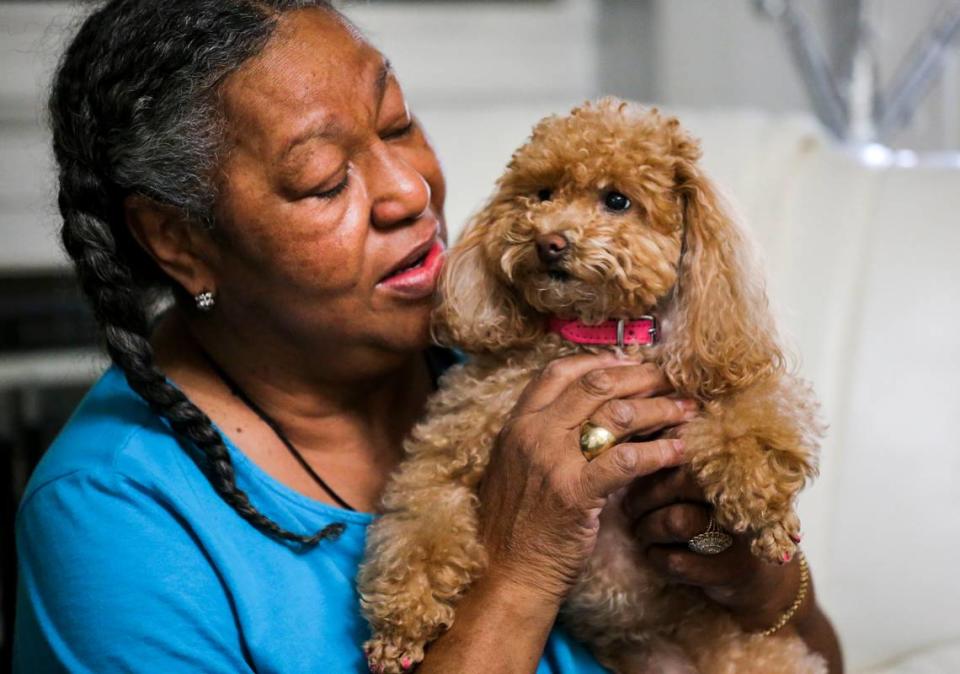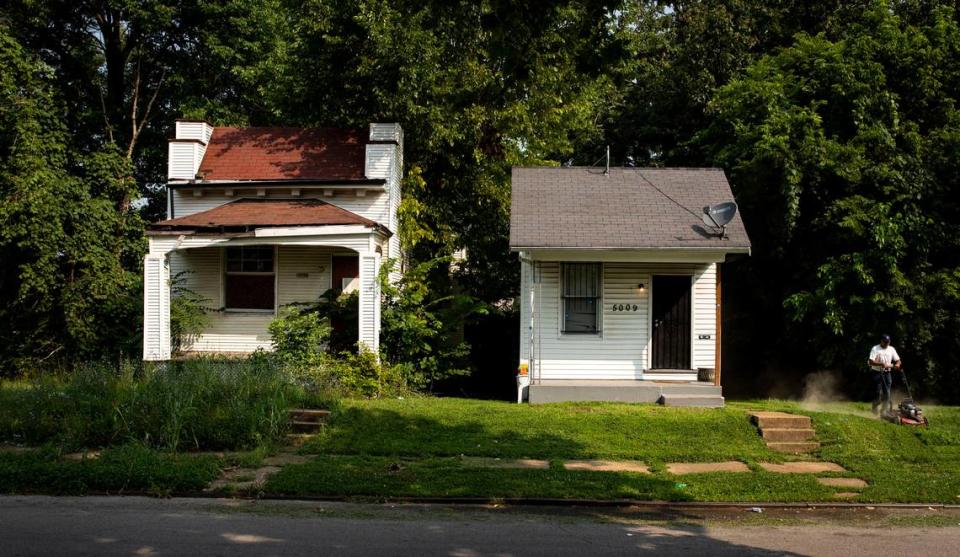‘We should be doing more’: In St. Louis and KC, fixing vacancy to reduce gun violence
At first, Chassidy Howard thought she was hearing fireworks. Then she felt the pain in her leg.
It was excruciating — she had been shot. Howard fell down behind a car and listened to her 26-year-old son Buddy call out from down the street.
“Mama, mama, I’ve been hit! I’ve been hit!” Buddy screamed.
Moments earlier, the 44-year-old mother and her son had been chatting with friends near their home on Genevieve Avenue in north St. Louis. They were out late that night in August 2013, and Buddy had just come over to tell his mom it was time to head home.
The house they had been sitting in front of was abandoned, as was the home across the street, where it was rumored the guns had been stashed until the shooting started.
It was another example of a phenomenon law enforcement, gun violence researchers and residents have described in different ways for years. Vacant lots and abandoned buildings attract crime, so much so that it almost seems as if bullets are drawn to them by a magnet, as in Howard’s case.
Both St. Louis and Kansas City are blighted with acres of abandoned property, owned publicly and privately. Gun violence follows the vacancy from neighborhood to neighborhood virtually without fail, data shows.
Ten people were killed in Howard’s neighborhood just last year. On her stretch of Genevieve Avenue, along the northeastern end of the Walnut Park East neighborhood, nearly 75% of the homes on the block have been abandoned. Some have been left to crumble for decades, though longtime residents remember when their street was cared for, and safer.
Vacant lots and shootings in St. Louis
A Star analysis of vacant property locations and shooting data in St. Louis shows that high concentrations of gun violence happen in areas with large amounts of abandoned lots and buildings. Four neighborhoods showed the highest rates of both shootings and vacancy. Source: The Gun Violence Archive and the St. Louis Land Reutilization Authority.
Across St. Louis, gun violence festers in neighborhoods riddled with vacant lots. The city has counted 25,000 of them. And the burden is not shared equally. North of Delmar Boulevard, which divides the city along racial and economic lines, 30% of properties are vacant, compared with only 3% in the south.
All but one of the top 10 neighborhoods for shootings had higher than average vacant lot rates, according to a Star analysis of data from the nonprofit Gun Violence Archive and the city’s land bank. Four of the 10 neighborhoods had the highest rates for both shootings and vacant lots.
Public health researchers have shown that the built environment of a community — including negative features like vacant lots and abandoned buildings — has an impact on the risk of gun violence. It is part of an overall picture of well-being in a neighborhood that includes factors such as income, housing, food insecurity and education. Cleaning up and maintaining neighborhoods can reduce gun crimes, studies show.
And in recent years, St. Louis has committed tens of millions of dollars to doing just that.

Voters in 2017 approved a $40-million bond issue for rehabbing vacant homes and buildings owned by the city’s land bank. In June, a new land trust was established with a $1 million grant from the state and matching funds.
Those investments are needed to uplift communities harmed not only by high vacancy and crime, but also poverty, said Neal Richardson, executive director of the St. Louis Development Corporation.
“We should be doing more,” Richardson said. “Right now, in the city of St. Louis, there are some streets, blocks and entire areas that are vacant. And that just creates pockets of challenges and dark spots within our city for crime to happen.”
On the other side of the state, Kansas City has not dedicated as many resources.
“Not many people recognize that the way a neighborhood looks and violent crime can relate,” said Kansas City Mayor Quinton Lucas. “When we come to the solution side we don’t actually think about how if we fix something like vacancy and housing we can lower our violent crime.”
To fully repair the generations of structural racism and systemic disinvestment in either city, experts say, would mean reinvesting hundreds of millions of dollars. Some even put the figure as high as $1 billion.
Even so, Howard believes Walnut Park can once again be a safer, thriving place to live and raise a family.
Today she operates a small barbecue stand next to a vacant home hardly a block from where she was shot. As she works, a slight limp from the gun injury is noticeable, her left calf bear the scars from the shooting.
“I took a bullet for Genevieve,” she said with a smile, flipping ribs on a charcoal grill.

Someday, she would like to convert one of the nearby vacant buildings to a brick-and-mortar restaurant serving rib tip sandwiches and chicken wings. She draws hope from the efforts of two neighbors, Troy Gardner and Sundy Whiteside, who remember what the neighborhood was once like and share a vision for its future. Both are longtime residents and Whiteside is a leader in the St. Louis vacancy effort.
“It’s so hard to see this neighborhood look like this,” Howard said. “I really want this to one day be a community and these two women are the reason I’m hopeful that it will. You still have people that stick around and care about this community.”
Life on Genevieve
The neighborhood was not always like this.
In 1975, When Troy Gardner’s mother bought a house on Genevieve, the neighborhood was thriving.
Every house on the block was cared for. Front lawns were mowed. Neighbors looked out for one another. Half of the residents were Black and the other half were white.
In the decades since, Gardner has seen how white flight, redlining and disinvestment have devastated this part of the city. She’s lived in her mother’s old home since the 1990s, and now shares it with her dog, Cupcake.
Gardner, 67, is one of the few residents remaining on her block. Across the street, six houses sit vacant and crumbling. The house to the left of hers hasn’t been occupied for 20 years, and it shows.
Around the corner on Beacon Avenue, the Johnson family used to own a candy store. But that has since been abandoned, and Gardner tries to avoid that block entirely because it isn’t safe.
As the families and businesses moved out, the gun violence moved in behind them.

Bullet holes now dot Gardner’s home, including one over the headboard in her mom’s old bedroom. Another has punctured the storm drain just above her rocking chair on the front porch. She has woken up at night to the sound of automatic gunfire, 60 rounds at a time.
Last year, she was dropping a slice of pie off at her neighbor’s house when she had to throw herself to the ground to avoid bullets flying down the street.
“For the first time in my life, I am scared,” Gardner said. “I have never once been scared. But I am now, and I am so tired.”
Fortunately, Gardner is not alone.
Up the block is Sundy Whiteside, who Gardner has known since she was a young girl. And together they are working on making their little corner of the world a better place.
Making a difference
Whiteside knocked on the door of a stranger’s home in an affluent section of south St. Louis.
When the homeowner answered, she told them the story of a sinking ship.
This was part of a city-wide effort Whiteside had joined in 2015 through the St. Louis Association of Community Organizations. They were seeking voter support for a bond issue to rehab thousands of vacant homes in St. Louis.
In talking to voters, Whiteside would compare St. Louis to a large ship with a hole in one side. While people on the side with the leaking hole are frightfully aware of how the ship is sinking, she would say, those on the other side remain oblivious.
Her point: even if residents in one neighborhood don’t live with the same struggles as the other, all of them should care because it affects the whole region.
“We have to think of ourselves as a big unit, rather than just 79 individual neighborhoods,” Whiteside said. “So when something happens over here, we have to work together to bring solutions, and not make it the burden of one geographical area.”
She and fellow organizers were campaigning for Proposition Neighborhood Stabilization, also known as Proposition NS, a $40-million bond to fund improvements on vacant homes owned by the St. Louis Land Reutilization Authority.

The bond passed in an April 2017 election, but a lengthy court battle delayed real action. It wasn’t until last year that the funds became available to fix up properties. The $40 million is distributed over roughly 7 years. Each year, about $6 million will go toward fixing 200 vacant LRA homes.
The Reutilization Authority, which is staffed by the St. Louis Development Corporation, will provide up to $30,000 to repair a single-family home or $50,000 for a multi-family unit or commercial property.
It’s not always enough to make the homes brand new again, but is meant to stabilize them so they can be sold to homeowners, individual rehabbers or small developers.
One crucial part, Whiteside said, is that the people in the neighborhoods have a say over which properties get selected for rehab. Anyone can nominate a property, and then each nomination is assessed to see what work needs to be done and the likelihood of the fixed-up home selling at auction.
The price of the homes is also supposed to remain affordable. A rehabbed home in Walnut Park would sell for around $500, Whiteside said. The idea is not to bring in gentrification, but to retain existing residents and give them the chance to be homeowners.
In June, a $1-million grant from the Missouri Department of Conservation, and matching funds from public and private sources, established a St. Louis Community Land Trust.
That will create a mechanism for community ownership, with a board primarily made up of residents of the neighborhoods. That way, plans are made with the neighborhoods in mind and the benefits are for the people who live there, said Laura Ginn, a vacancy strategist who works for the St. Louis Land Reutilization Authority.
It’s all about putting power in the hands of the people, she said.
More to come
The Missouri Gun Violence Project’s series on public health issues and gun violence will continue. Coming soon will be the final story in this series, focused on schools. Additional stories will examine gun violence prevention programs and the legacy of state gun laws.
Whiteside now serves as board president of the St. Louis Association of Community Organizations and co-chairs the Vacancy Collaborative’s advisory committee. She still sees more that needs to be done and wants more long-term and sustainable funding for improving vacant land.
Ginn estimates that, to clean up all the vacant property in the city’s land bank, it would cost $100 million a year for five years, and then $15 million a year after that to continue maintaining the land.
“I would estimate it’s at least a billion dollars worth of investment needed to help historically disinvested communities in Kansas City,” said Geoff Jolley, executive director of the Greater Kansas City Local Initiative Support Corporation.
“And when I tell funders that they get real nervous, they’ll say, but we’ve put a few million dollars into this. But a few million dollars isn’t going to change a neighborhood that has had years of lack of intention and investment.”
In order for those funds to be spent wisely, advocates and researchers say they must work with neighborhood leaders who know their community best.
Kansas City
In Kansas City, the nonprofit Urban Neighborhood Initiative has recommended the city create a bond issue similar to St. Louis’ Proposition NS.
That could generate resources that would go toward vacancy and housing, the group suggested.
Neighborhood leaders have long been trying to address vacancies and blight in their communities. It was one of the first things Dianne Cleaver heard about when she became president of the nonprofit in 2013.
“All of our neighborhoods were very concerned about their vacancies, because they breed crime and blight,” Cleaver said.
All but one of the 10 Kansas City neighborhoods with the most vacancy also had higher than average shooting rates, according to a Star analysis of land bank data and shooting locations. Six of the neighborhoods were in the top 10 for both their rate of vacant land and shootings.
Vacant lots and shootings in Kansas City
A Star analysis of vacant lot locations and police data shows that the two ZIP codes with the most vacancy in Kansas City — 64127 and 64130 — are also home to neighborhoods with the most shootings. Source: The Kansas City Land Bank and the Kansas City Police Department
In 2015, the Urban Neighborhood Initiative started Vacant to Vibrant, a program to rehab vacant lots and buildings in 10 neighborhoods, including Blue Hills, Ivanhoe and Manheim Park.
The effort seeks to reduce barriers to working on a vacant property, clearing titles and encouraging developing vacant land into affordable housing, green spaces and urban farms. The nonprofit also created a calculator to estimate the time and money needed to fix up a given property.
When Vacant to Vibrant started, Cleaver said, roughly 50% of the land in the 10 neighborhoods was vacant. Now, it’s down to 39%.
Kansas City doesn’t have nearly as much publicly owned vacant land as St Louis — the city’s Land Bank currently manages nearly 3,000 vacant properties of all kinds.
But so far, Kansas City also has not invested in solutions the way other cities have.
RSVP: Join a discussion on improving neighborhoods, reducing gun violence in Missouri
Some efforts in recent years, including a citywide sales tax for development on the Prospect Corridor and a housing trust fund, have included goals of rehabbing vacant properties but were focused also on other priorities.
A housing trust fund established by the Kansas City Council in 2018 never received funding until last year, when the city put in $12.5 million in federal dollars from the American Rescue Plan. The trust fund is meant to focus on housing, not the problem of vacancy specifically.
“We are calling for a more comprehensive approach instead of these piecemeal approaches, they are piecemeal because we have piecemeal powers, “ Cleaver said. “So we have to find a way to get significant dollars into this issue — then you can begin to look at more comprehensive approaches.
“Funding really is the biggest challenge,” she said. “It’s not like the city doesn’t want to address this issue.”

